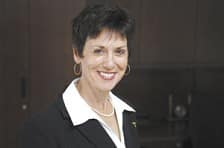A Closer Look: Karen McLean

.floatimg-left-hort { float:left; } .floatimg-left-caption-hort { float:left; margin-bottom:10px; width:300px; margin-right:10px; clear:left;} .floatimg-left-vert { float:left; margin-top:10px; margin-right:15px; width:200px;} .floatimg-left-caption-vert { float:left; margin-right:10px; margin-bottom:10px; font-size: 12px; width:200px;} .floatimg-right-hort { float:right; margin-top:10px; margin-left:10px; margin-bottom:10px; width: 300px;} .floatimg-right-caption-hort { float:left; margin-right:10px; margin-bottom:10px; width: 300px; font-size: 12px; } .floatimg-right-vert { float:right; margin-top:10px; margin-left:10px; margin-bottom:10px; width: 200px;} .floatimg-right-caption-vert { float:left; margin-right:10px; margin-bottom:10px; width: 200px; font-size: 12px; } .floatimgright-sidebar { float:right; margin-top:10px; margin-left:10px; margin-bottom:10px; width: 200px; border-top-style: double; border-top-color: black; border-bottom-style: double; border-bottom-color: black;} .floatimgright-sidebar p { line-height: 115%; text-indent: 10px; } .floatimgright-sidebar h4 { font-variant:small-caps; } .pullquote { float:right; margin-top:10px; margin-left:10px; margin-bottom:10px; width: 150px; background: url(http://www.dmbusinessdaily.com/DAILY/editorial/extras/closequote.gif) no-repeat bottom right !important ; line-height: 150%; font-size: 125%; border-top: 1px solid; border-bottom: 1px solid;} .floatvidleft { float:left; margin-bottom:10px; width:325px; margin-right:10px; clear:left;} .floatvidright { float:right; margin-bottom:10px; width:325px; margin-right:10px; clear:left;}
How did you become interested in the medical field?
My original degree was as a physical therapist. The summer before I started physical therapy school, my oldest brother was in a motorcycle accident and became a paraplegic, and ever since that time I really wanted to work with spinal-cord-injury patients. So when I took my first job, I left the safety of rural America and moved to the inner city of Detroit, because I wanted to work at a large spinal-cord rehab center.
What led to your career in higher education?
Eventually I came back (to Wisconsin), did my master’s in La Crosse in adult fitness and cardiac rehab and did a Ph.D. at Arizona State, and worked at the University of Wisconsin-La Crosse for 22 years. I have always had the desire to teach, to be in education. I came from a family of eight children; I was the oldest girl. So even when I was a small child, we played school and I was always the teacher. Though I became a physical therapist, I think that desire to teach, whether one-on-one or in a classroom setting, was always in the back of my mind. After I finished my Ph.D. (in 1992), that’s when I really pursued academia full time.
Were you looking for an opportunity outside Wisconsin?
I had been in college-level administration for almost 10 years (at University of Wisconsin-La Crosse), and I was looking at an opportunity to move into a provost position. This particular position was interesting to me because it capitalized on understanding some of the unique challenges of providing health-care education, which is typically very expensive. Usually, clinicians practice first, much like I did, and then come into teaching much later in their career, and they require a whole different level of development. So preparing them to be faculty members, that’s a slightly different challenge. And the program array here was very appealing.
What else attracted you to DMU?
The other thing I didn’t have a total appreciation for until I came to the campus was the amazing infrastructure that exists here. The state-of-the-art labs, very modern, well-maintained buildings are not very common in a lot of public higher-ed institutions, particularly in Wisconsin. The other thing I found really appealing about this university is I felt like they walk the talk when it comes to wellness. I think this university is making a tremendous effort with its wellness program for employees and also for students.
What are your impressions of Des Moines?
I had never stopped in Des Moines before, other than to get gas on the way to Colorado. I was very pleasantly surprised to find that it was such a vibrant city, and yet very easy to negotiate. One thing that’s very important to me is an active lifestyle, and the variety of walking and biking trails makes the outdoor recreational activities pretty impressive. I made a conscious decision to live in the city; I wanted to be able to walk to work or to walk downtown. I just never saw myself living in Iowa, and now, I think I feel like an Iowan.
You’re DMU’s first provost. What are your plans?
This institution has grown up as a podiatry college, a medical college and now a very big and growing college of health sciences that have all functioned fairly independently. As the chief academic officer, I can bring these three independent colleges together, and upgrade some of the practices they have into the 21st century.
What are some of the first tasks you’ll deal with?
Probably one of my first big jobs will be leading the self-study process (for reaccreditation) on campus. This just comes at a great time, because a self-study really helps us to take a critical look at things – what’s working, what would we like to change? I think the next two years as we go through that process, we’ll be looking at a lot of things we do to see what we could do better. I think coming from the outside, I bring a different perspective. Des Moines University has been on this very positive trajectory for the last six, seven, eight, nine years. I think it’s exciting to join it and be a part of really taking it to that next level.








